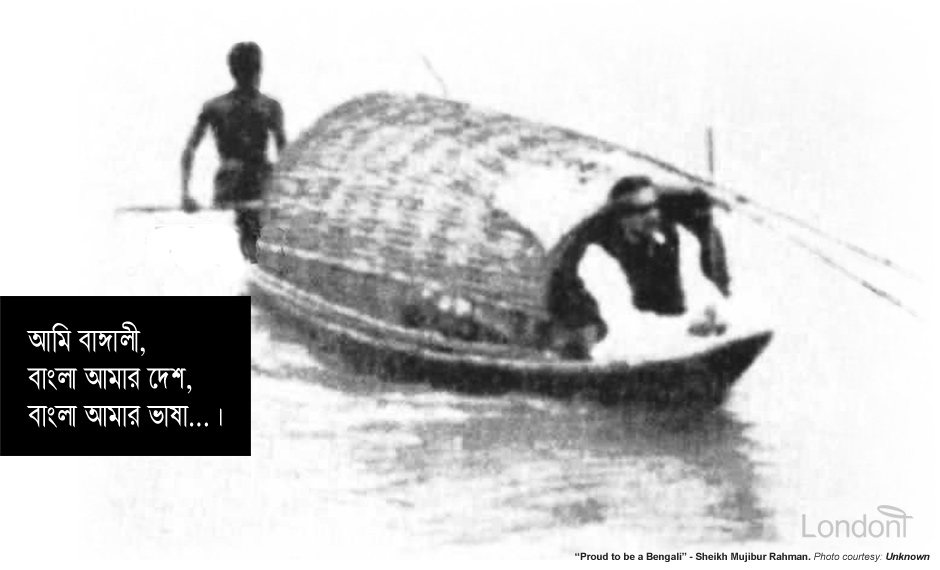
Sheikh Mujib: "East Pakistan will now be called Bangla Desh"
On 5 December 1969 at a meeting to observe the death anniversary of Huseyn Shaheed Suhrawardy, Sheikh Mujibur Rahman declared that East Pakistan will henceforth be called 'Bangla Desh' (Land of Bengal).
This was a foretaste of things to come.
On behalf of the people of Bengal, I am announcing today that henceforth the eastern province of Pakistan will, instead of being called East Pakistan be called Bangladesh. There was a time when all efforts were made to erase the word "Bangla" from the land and its map. The word "Bangla" was found nowhere except in the term Bay of Bengal. I announced today that this land will be called Bangladesh instead of East Pakistan.
Yahya simultaneously started negotiations with Mujib, Bhutto, and various other political leaders about the restoration of civilian and democratic rule. The task before him was complex. The Islamic right-wing parties in Pakistan, such as the Jamaat-e-Islami, the Jamaat-ul-Ulema-e-Islam, and the Jamaat-ul-Ulema-e-Pakistan, favoured a strong, centralised government with an Islamic constitution. The non-Awami League parties in East Pakistan wanted greater autonomy but were disinclined to support Mujib's radical Six-Point Programme. Bhutto and the PPP made vague statements about their commitment to socialism and Islam. They also expressed reservations about [British] Westminister-style democracy but did not clarify their views on issues of power-sharing between the two wings of Pakistan.
 Abul A'la Mawdudi ( 1903 – 1979)
Abul A'la Mawdudi ( 1903 – 1979)
'One Unit' dissolved and proportional representation implemented
During his radio broadcast on 28 November 1969, President Yahya affirmed that the parity [equal status] of representation in the National Assembly between the two wings that had existed under the 1956 and 1962 constitutions would end and the representation would be based on population. This move delighted the East Pakistanis, because it meant that their province would now occupy the majority of the seats in the National Assembly, reflecting East Pakistan's larger population base. The arrangement meant the National Assembly would consist of 313 seats (or members) - 169 seats from East Pakistan (with 7 reserved for women) and 144 seats for West Pakistan (with 6 for women). Women were also allowed to contest the elections from general seats.
Maximum autonomy to the two wings of Pakistan as long as this does not impair the national integrity and solidarity of the country...People of both East and West Pakistan are almost unanimous in demanding the break-up of One Unit. My decision is, therefore, based on a popular wish. People of the two regions of Pakistan should have control over their economic resources and development as long as it does not adversely affect the working of a national government at the Centre.
President Yahya on the dismantling of 'One Unit' system in a national broadcast on 28 November 1969
President Yahya's regime made no attempt to frame a constitution. The expectations were that a new constituent assembly would be set up by holding a free and fair election. In order to hold the proposed elections, President Yahya appointed a team to draft a new constitutional formula. Four months later, this formula was officially issued and is known as the Legal Framework Order (LFO) of 1970.
In an attempt to assuage regional grievances about the political dominance of Punjabis, President Yahya agreed to dismantle the 'One Unit' scheme. On 1 July 1970, the One Unit of West Pakistan was dissolved restoring the four provinces of the Punjab, Sind, NWFP (North West Frontier Province) and Baluchistan. East Pakistan remained as a single province, though it's name was not reverted back to 'East Bengal'.
Yahya dismantled one unit of Western Pakistan that Ayub envisioned with Basic Democracy in 1962. Thus, Punjab, Sindh, Baluchistan, and Sarhad (North-West Frontier) came back in the map of Pakistan. Since these names appeared again in the map but the mystery remains with the name of the Eastern wing. Ayub installed two names for two wings of Pakistan which was pretty easy to note based on their location on the global map. Yahya remained silent about reviving Eastern Bengal for Eastern Pakistan as a province. This silence did not cause problem with the sentiment of the people of the then Eastern Pakistan concerning the name of the Province.
